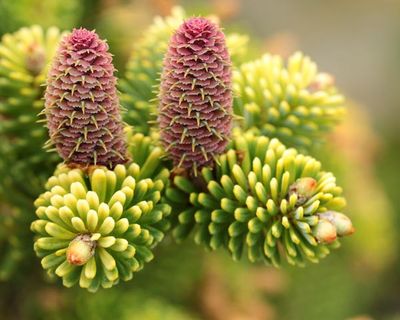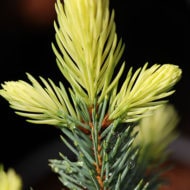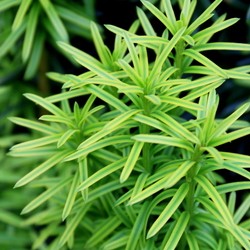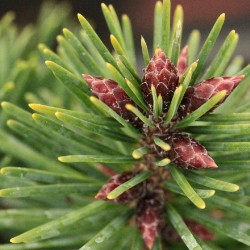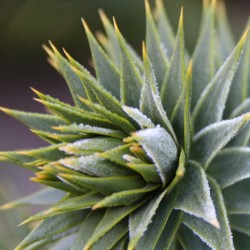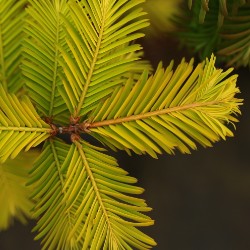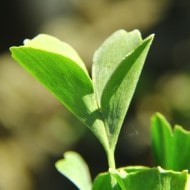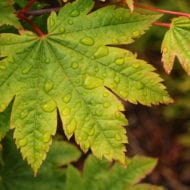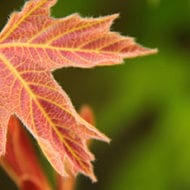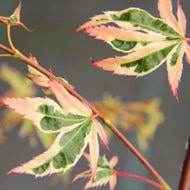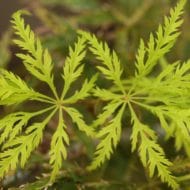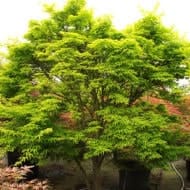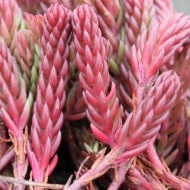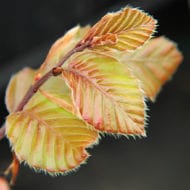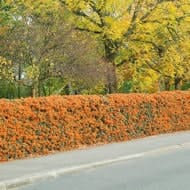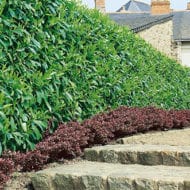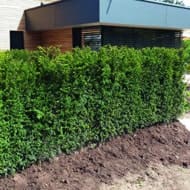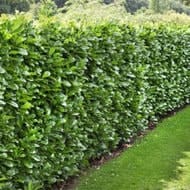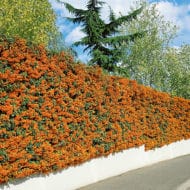If making eye contact with your neighbors while enjoying your morning coffee from your patio makes you uncomfortable, maybe it’s time to think about having the fastest-growing trees for privacy. Planting evergreens or conifers in your garden can help you keep unwanted eyes off your property. Even if you really like your neighbors, chances are you don’t want them watching you relax in your living room, or worse, your hot tub! By using fast-growing evergreen trees for privacy, you can easily create a dense, effective, and beautiful screen.

Evergreens vs Fences for Privacy Borders
When faced with a need for privacy, many will consider a fence. While fences can be very nice, there are several major benefits to using evergreens for privacy instead.
- Cost – Planting an evergreen privacy screen instead of building a fence can cost a similar or much lower amount, and while fences degrade over time and eventually need to be replaced, hedges and borders improve over time, becoming taller and denser.
- Aesthetics – Fences can be beautiful if well-made, but an evergreen screen full of different colors, shapes, and textures adds unparalleled beauty to the landscape. It also provides a habitat for birds and other small animals.
- Windbreak – Tall privacy trees and evergreen shrubs planted in a border or hedge create an effective windbreak. Make sure to plant them on the side of your house that receives the most wind and you will notice an immediate difference.
- Noise – Living borders made of trees and shrubs also effectively buffer noise. Soften road, train, and neighbor noise with a beautiful living border.
- Height – Cities often have rules about how high you can build a fence, but hedges and borders can be grown to any height. This is especially useful if you need privacy on or from a second story where a 6-foot fence isn’t helpful.
Best Fast-Growing Privacy Trees and Shrubs
So, what are the best trees and shrubs to use? You will definitely want to use evergreen trees for privacy that offer fast growth. Sometimes deciduous trees and shrubs can be used in a mixed border for added color or flowers, but they don’t provide year-round screening and shouldn’t be the main backbone of the border. For a tall privacy screen, you will need some privacy trees with rapid growth.
There are multiple ways to create privacy screens with evergreen trees and shrubs. The method you use will depend on what your privacy needs are.
FIRST METHOD: IMPLIED BORDERS
Implied borders make an informal but effective screen for privacy. These usually involve a mix of tall and narrow trees, fast-growing privacy trees, colorful trees, and sometimes deciduous and flowering trees and shrubs to add seasonal interest.

Tall & Narrow Trees
Looking for the best evergreen tree to block neighbors? Tall, narrow trees are perfect for blocking specific spots. Maybe you have a few windows that look straight into your neighbor’s house. Or maybe your neighbor has a second-story window with a great view directly to your swimming pool. You will want some tall, narrow but fast-growing evergreen trees for privacy.
1. Pinus nigra ‘Frank’ –Austrian Pine

Frank grows nearly straight upright to form a narrow pyramid over time. It grows at a moderate pace of 6-12” per year. It has short, dark green needles and striking white buds in winter, making it a great privacy tree for backyards.
USDA Zone – 4
Mature Height by Width –10’x2’
2. Pinus nigra ‘Green Tower’ –Austrian Pine

Green Tower is a sturdy, upright pine that is extremely tall and narrow. It has nice dark green foliage. The branches are unusually sturdy, making them hold up well against snow and ice. This Austrian Pine performs great in winter, making it the best privacy tree.
USDA Zone – 4
Mature Height by Width – 8’x18”
3. Pinus mugo ‘Fastigiata’ – Mugo Pine

This mugo pine grows tall and narrow at a rate of about 9” per year. It has sturdy branches that can hold up against ice and snow. It has a rich green color and is a great choice for small spaces.
USDA Zone – 2
Mature Height by Width – 9’x3’
4. Pinus strobus ‘Stowe Pillar’ – Eastern White Pine

This white pine has dense, soft foliage and grows straight up. It grows 9-12” pear year and is excellent for hiding specific eyesores and windows.
USDA Zone – 3
Mature Height by Width – 8’x2’
5. Pinus strobus ‘Bennett’s Fastigiate’ – Eastern White Pine

Bennett’s Fastigiate is a tall, narrow pine that tolerates snow load well thanks to its sturdy branches. Its foliage is soft, dense, and a lovely shade of blue-green. It grows 9-12” per year, making it an excellent tree for privacy from neighbors.
USDA Zone – 4
Mature Height by Width – 8’x2’
6. Taxus x media ‘Sentinalis’– Hybrid Yew

This upright yew makes a beautiful addition to any privacy border with its dark green, curled foliage. This is a good choice for shady areas. It grows 6-12” per year.
USDA Zone – 6
Mature Height by Width – 10’x2’
7. Picea abies ‘Cupressina’ – Norway Spruce

Cupressina is a popular vertical-growing spruce that is perfect for narrow spaces. It grows about 12” per year and is very dense.
USDA Zone – 4
Mature Height by Width – 10’x2.5’
8. Thuja occidentalis ‘Smaragd’ – Emerald Green Arborvitae
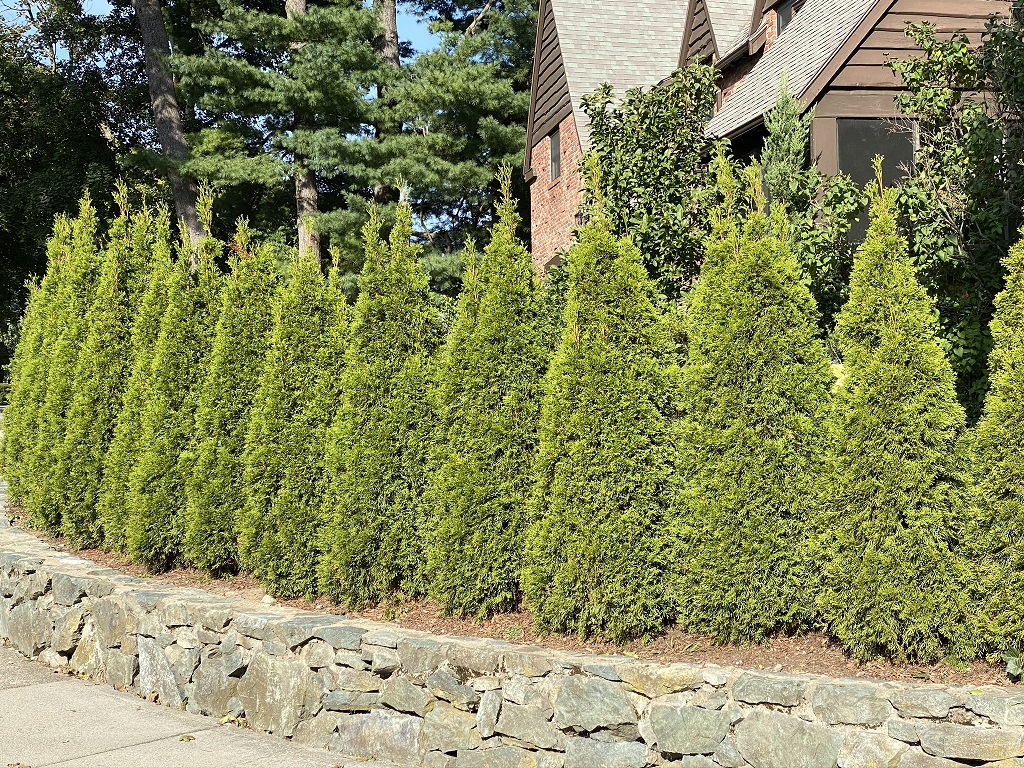
This columnar, dense evergreen is extremely popular as a privacy tree or hedge. Many people will use it to create an arborvitae fence of sorts. It does well planted close like a hedge, but could also be used as a vertical accent.
USDA Zone – 3
Mature Height by Width – 8’x2’
Fast-Growing Evergreen Trees for Privacy
Fast-growing evergreen trees and shrubs are useful for creating tall, thick privacy borders to screen large areas. They can be pruned periodically to increase the thickness or left to grow naturally to get maximum size. Here are some of the top fast-growing evergreens for privacy.
1. Thuja x ‘Green Giant’ – Hybrid Arborvitae
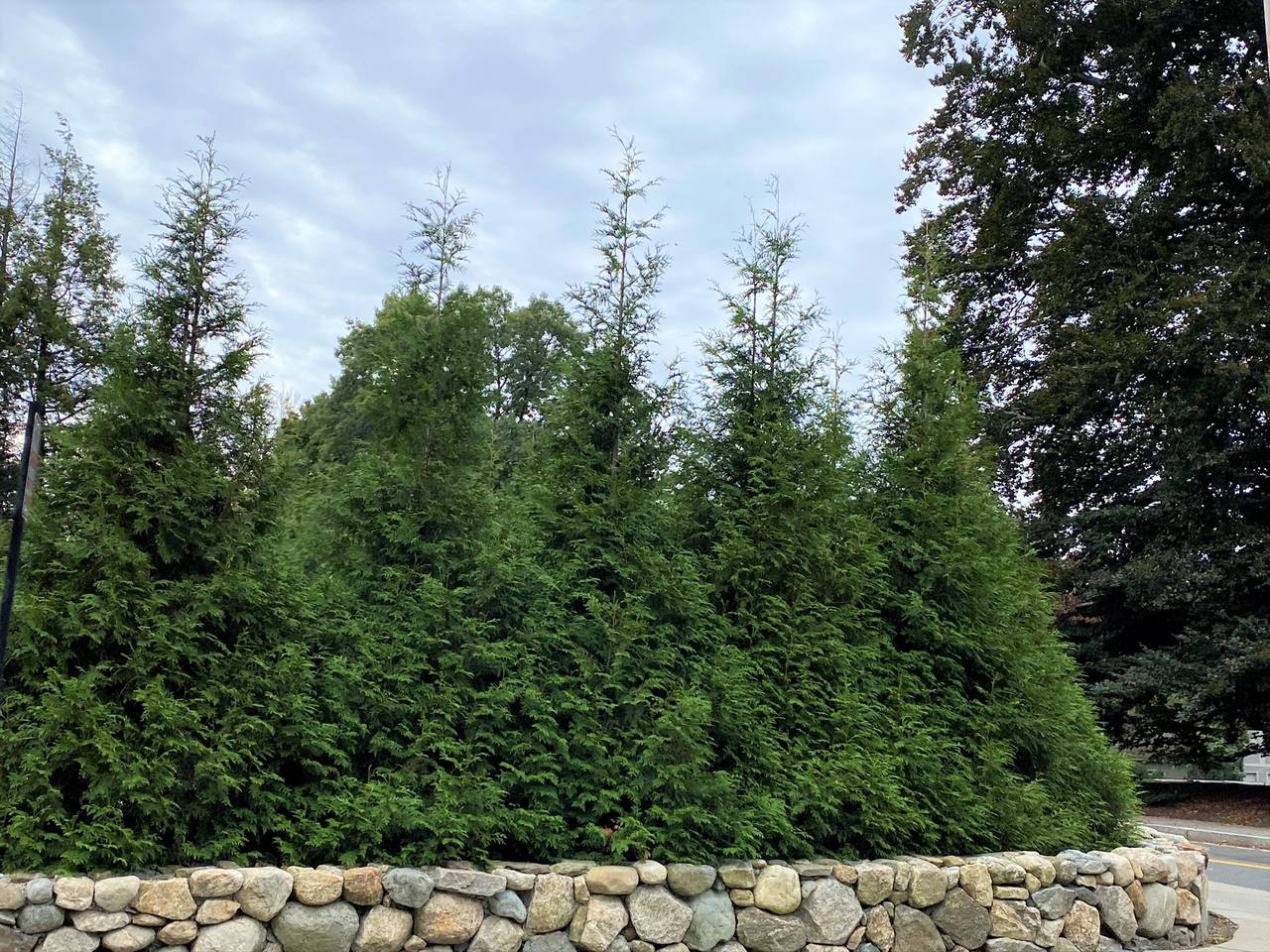
Green Giant might be the best evergreen for privacy. It has an extremely fast growth rate, putting on 3-4’ per year. It grows well in the humid southeast, which is unusual for Arborvitae. It is a much better option over a Leyland cypress privacy screen because Green Giant is easier to maintain and does not overgrow and brown out like Leyland tends to do. It also has good deer resistance.
USDA Zone – 5
Mature Height by Width – 30’x12’
2. Prunus lauroceraus – English laurel

English laurel is one of the best and fastest-growing evergreen shrubs for privacy. It grows fast, up to 2-3 feet per year, and creates a large, dense screen. It can be pruned hard to increase density. It is strongly deer-resistant.
USDA Zone – 6
Mature Height by Width – 12’x8’
3. Thuja plicata ‘Virescens’ – Western Red Cedar

Virescens is a fast, upright-growing selection of the West Coast’s native Western Red Cedar. It has good deer resistance and can tolerate partial shade. It has a lovely green color that lasts all winter.
USDA Zone – 5
Mature Height by Width – 12’x4’
Fast-Growing Colorful Evergreens For Privacy
Colorful evergreens are a wonderful addition to a mixed evergreen privacy border. Some only turn color in the winter, adding seasonal interest.
1. Chamaecyparis lawsoniana ‘Pembury Blue’ – Lawson Cypress

Pembury Blue is a dense, upright evergreen with feathery, powder-blue foliage. It grows 9-12” per year into a graceful, loose pyramid.
USDA Zone – 5
Mature Height by Width – 9’x5’
2. Cryptomeria japonica ‘Elegans’ – Elegant Japanese Cedar
Elegans makes a bold statement in winter months when it turns bright copper-purple! It grows 10-12” per year and has lovely, feathery foliage.
USDA Zone – 6
Mature Height by Width – 12’x4.5’
3. Cryptomeria japonica ‘Sekkan’ – Japanese cedar

This Japanese cedar boasts bright yellow foliage year-round, with the brightest show on new growth in spring. It grows quickly (12-15” per year) to become a large, dense pyramid.
USDA Zone – 6
Mature Height by Width – 12’x3.5’
SECOND METHOD: HEDGES
Hedges are a more formal and thorough way to gain privacy. Plants are first placed in fairly tight rows, then pruned repeatedly to create density and uniform shape. Using an InstantHedge can be an exciting way to make improvements. Many different plants that can be hedged, but these are some of the best fast-growing privacy hedges.
1. Thuja x ‘Green Giant’– Hybrid Arborvitae

Green Giant is one of the fastest growing evergreens, and it makes a beautiful hedge. With pruning, expect 1-2 feet of growth per year. You could also allow it to grow faster to reach larger heights, then simply prune to maintain the size.
USDA Zone – 5
Mature Height By Width – 20’x4’ PRUNED
2. Thuja plicata ‘Virescens’– Western Red Cedar

Virescens grows quickly and in a narrow shape. It has bright green, feathery foliage that looks beautiful all winter. It is deer resistant and tolerates partial shade.
USDA Zone – 5
Mature Height by Width – 10’x4’ PRUNED
3. Prunus laurocerasus – English laurel

English laurel responds well to pruning, so even though it grows fast it can be sheared repeatedly to increase density, making it an excellent hedge. It is tolerant of poor soil conditions and is drought resistant once established. It is also highly deer resistant.
USDA Zone – 6
Mature Height by Width – 10’x6’
4. Prunus laurocerasus ‘Schipkaensis’ -Schip laurel

Schip laurel is a shade-loving alternative to English laurel. Its foliage is a beautiful deep green. It also tends to grow upright and narrow, making it better for small spaces.
USDA Zone – 6
Mature Height by Width – 10’x4’
How to Plant a Privacy Screen?
When planting a border, it is best to select a variety of shapes, sizes, textures, and colors. You can plant in a slightly staggered row to make it look natural. Consider the mature size of the plants when deciding how close to plant them – you want to allow space for growth, but you also want them to fill in the gaps in a reasonable time frame. Narrow-growing trees and shrubs can be placed 2-3 feet apart, while more spreading varieties can be placed 3-5 feet apart.
A hedge should be planted in a straight row with fairly tight spacing. Narrow varieties can be planted 1-2 feet apart and wider varieties can be planted 2-3 feet apart. Consistent, careful pruning then turns the individual plants into a uniform hedge over the next 4-5 years.
InstantHedge can be used to create a perfect privacy hedge without the wait of a traditional hedge. These are pre-finished, mature hedges that are ready to be planted and enjoyed right away. You dig a trench that is 12 inches deep and at least 18 inches wide. Then you set the finished hedge units in the trench end-to-end for perfect spacing, fill back in with soil, water well, and that’s it!
Maintaining a Privacy Screen
Pruning in a border can be minimal as long as care has been taken when planting to give all the plants the correct spacing. If something begins to grow too large for its allotted space, consider pruning carefully for size control or replacing it with something more appropriately sized. For traditional hedges, prune the sides and tops lightly for shape for the first several years, then lightly prune for size control once the desired shape has been achieved. For InstantHedges, simply trim to maintain the desired shape and size once per year.
Water is crucially important for the first several years after planting. Water deeply to help the roots get established. Drip irrigation is a great way to achieve this as it allows for deep watering and minimizes water waste.
Slow-release fertilizer is perfect for keeping your privacy border or hedge healthy. Apply once per year. We offer a great blend for fertilizing conifers.
Mulch is very beneficial for borders and hedges, as it helps protect roots, increases soil fertility, and helps conserve moisture. Mulching each year will really help improve the soil quality over time.
Privacy trees are a great way to add value to your home, improve your curb appeal, and create a more private and relaxing outdoor space. There are many different types of privacy trees to choose from, so you can find the perfect ones to fit your needs and style. Whether you choose evergreens or a colorful variety of fast-growing privacy trees from Conifer Kingdom, you won’t be disappointed.


